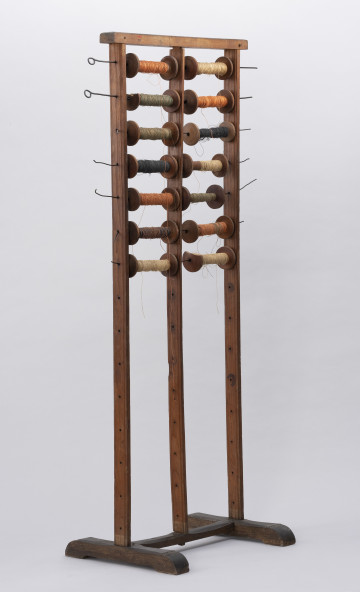
Weaving shuttle
1880 — 1920
National Museum in Szczecin
Part of the collection: Material culture of West Pomerania
Weaving boards, known as heddles, were small tools made of wood. There were used for weaving the so-called krajki – narrow bands, usually made of wool, which once served various purposes. These bands were used to reinforce the edges of garments, to support trousers or, in both men’s and women’s clothing, to girdle shirts. They were also used in folk ceremonies. The weaving heddles could be plain or decorated with an engraved or cut-out pattern. In the entire Western Pomerania, heddles decorated with very sophisticated wood carvings were common, often depicting the motif of a several-armed, straight or swirling rosette. Weaving with a heddle required a certain amount of skill. The weaver would thread the warp threads through slits cut in the length of the board and holes in the bars that separated them, then attach one end, for example to the bed frame, and tie the other end around the waist. She then pulled the threads tightly and positioned them so that they were all level with the holes. Lifting the board, and with it the odd threads in the holes, she created a space above the even threads through which she threaded the weft. When the board was pulled downwards, a space was formed under the even threads and the thread was closed. The finished bands were ended in various ways, e.g., with knots, braids or tassels. The art of weaving with a heddle has been almost forgotten. Museums and other cultural institutions try to bring it closer by organising workshops where everyone can make their own krajki inspired by folk costumes. Colourful bands, hand-made in a traditional technique using a weaving board are used, for example, as bracelets, and are perfectly in line with the current trend of using ethnic patterns in clothing. In the collection of the National Museum in Szczecin, there is a heddle from the second half of the 19th century, decorated with a cut-out motif of a heart and a cross.
Agnieszka Słowińska
Author / creator
Dimensions
cały obiekt: height: 27,3 cm, width: 16,3 cm
Object type
weaving equipment
Creation time / dating
Creation / finding place
Identification number
Location / status

1880 — 1920
National Museum in Szczecin

1801 — 1939
National Museum in Szczecin

1851 — 1900
National Museum in Szczecin
DISCOVER this TOPIC
National Museum in Lublin
DISCOVER this PATH
Educational path